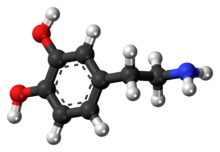User:Mr. Ibrahem/Dopamine
 | |
 | |
| Clinical data | |
|---|---|
| Trade names | Intropin, Dopastat, Revimine, others |
| Other names | 2-(3,4-Dihydroxyphenyl)ethylamine; 3,4-Dihydroxyphenethylamine; 3-hydroxytyramine; DA; Intropin; Revivan; Oxytyramine; Prolactin inhibiting factor; Prolactin inhibiting hormone |
| AHFS/Drugs.com | Monograph |
| License data | |
| Routes of administration | Intravenous injection |
| Physiological data | |
| Source tissues | Substantia nigra; ventral tegmental area; many others |
| Target tissues | System-wide |
| Receptors | D1, D2, D3, D4, D5, TAAR1[1] |
| Agonists | Direct: apomorphine, bromocriptine Indirect: cocaine, amphetamine |
| Antagonists | Neuroleptics, metoclopramide, domperidone |
| Metabolism | MAO, COMT,[1] ALDH, DBH, MAO-A, MAO-B, COMT |
| Legal status | |
| Legal status |
|
| Pharmacokinetic data | |
| Metabolism | MAO, COMT,[1] ALDH, DBH, MAO-A, MAO-B, COMT |
| Onset of action | Within 5 min[2] |
| Excretion | Kidney |
| Identifiers | |
| |
| Chemical and physical data | |
| Formula | C8H11NO2 |
| Molar mass | 153.181 g·mol−1 |
| 3D model (JSmol) | |
| Density | 1.26 g/cm3 |
| Melting point | 128 °C (262 °F) |
| Boiling point | decomposes |
| |
| |
| (verify) | |
Dopamine, sold under the brandname Intropin among others, is a medication most commonly used in the treatment of very low blood pressure, a slow heart rate that is causing symptoms, and, if epinephrine is not available, cardiac arrest.[2] In newborn babies it continues to be the preferred treatment for very low blood pressure.[4] In children epinephrine or norepinephrine is generally preferred while in adults norepinephrine is generally preferred for very low blood pressure.[5][6] It is given intravenously or intraosseously as a continuous infusion.[2] Effects typically begin within five minutes.[2] Doses are then increased to effect.[2]
Common side effects include worsening kidney function, an irregular heartbeat, chest pain, vomiting, headache, or anxiety.[2] If it enters into the soft tissue around the vein local tissue death may occur.[2] The medication phentolamine can be given to try to decrease this risk.[2] It is unclear if dopamine is safe to use during pregnancy or breastfeeding.[2] At low doses dopamine mainly triggers dopamine receptors and β1-adrenergic receptors while at high doses it works via α-adrenergic receptors.[2]
Dopamine was first synthesized in a laboratory in 1910 by George Barger and James Ewens in England.[7] It is on the World Health Organization's List of Essential Medicines.[8] The wholesale cost in the developing world of a container of 400 mg is between $0.28 and $0.60 (USD) as of 2014.[9] In human physiology dopamine is a neurotransmitter as well as a hormone.[10]
References[edit]
- ^ a b "Dopamine: Biological activity". IUPHAR/BPS guide to pharmacology. International Union of Basic and Clinical Pharmacology. Archived from the original on 5 February 2016. Retrieved 29 January 2016.
- ^ a b c d e f g h i j k "Dopamine Hydrochloride". drugs.com. American Society of Health-System Pharmacists. June 29, 2016. Archived from the original on 14 September 2016. Retrieved 15 July 2016.
- ^ "WHOCC - ATC/DDD Index". www.whocc.no. Archived from the original on 29 October 2020. Retrieved 21 September 2020.
- ^ Bhayat, SI; Gowda, HM; Eisenhut, M (8 May 2016). "Should dopamine be the first line inotrope in the treatment of neonatal hypotension? Review of the evidence". World Journal of Clinical Pediatrics. 5 (2): 212–22. doi:10.5409/wjcp.v5.i2.212. PMC 4857235. PMID 27170932.
{{cite journal}}: CS1 maint: unflagged free DOI (link) - ^ De Backer, D; Aldecoa, C; Njimi, H; Vincent, JL (March 2012). "Dopamine versus norepinephrine in the treatment of septic shock: a meta-analysis*". Critical Care Medicine. 40 (3): 725–30. doi:10.1097/ccm.0b013e31823778ee. PMID 22036860.
- ^ Dellinger, RP; Levy, MM; Rhodes, A; Annane, D; Gerlach, H; Opal, SM; Sevransky, JE; Sprung, CL; Douglas, IS; Jaeschke, R; Osborn, TM; Nunnally, ME; Townsend, SR; Reinhart, K; Kleinpell, RM; Angus, DC; Deutschman, CS; Machado, FR; Rubenfeld, GD; Webb, SA; Beale, RJ; Vincent, JL; Moreno, R; Surviving Sepsis Campaign Guidelines Committee including the Pediatric, Subgroup (February 2013). "Surviving sepsis campaign: international guidelines for management of severe sepsis and septic shock: 2012". Critical Care Medicine. 41 (2): 580–637. doi:10.1097/CCM.0b013e31827e83af. PMID 23353941.
- ^ Fahn S (2008). "The history of dopamine and levodopa in the treatment of Parkinson's disease". Movement Disorders. 23 Suppl 3: S497–508. doi:10.1002/mds.22028. PMID 18781671.
According to Hornykiewicz,6 dopamine was first synthesized by George Barger and James Ewens in 1910 at the Wellcome labs in London, England.
- ^ World Health Organization (2019). World Health Organization model list of essential medicines: 21st list 2019. Geneva: World Health Organization. hdl:10665/325771. WHO/MVP/EMP/IAU/2019.06. License: CC BY-NC-SA 3.0 IGO.
- ^ "Dopamine". International Drug Price Indicator Guide. Archived from the original on 22 January 2018. Retrieved 5 December 2015.
- ^ Millar, Thomas (2002). Biochemistry explained : a practical guide to learning biochemistry. London: Routledge. p. 40. ISBN 9780415299411. Archived from the original on 2016-08-15.
